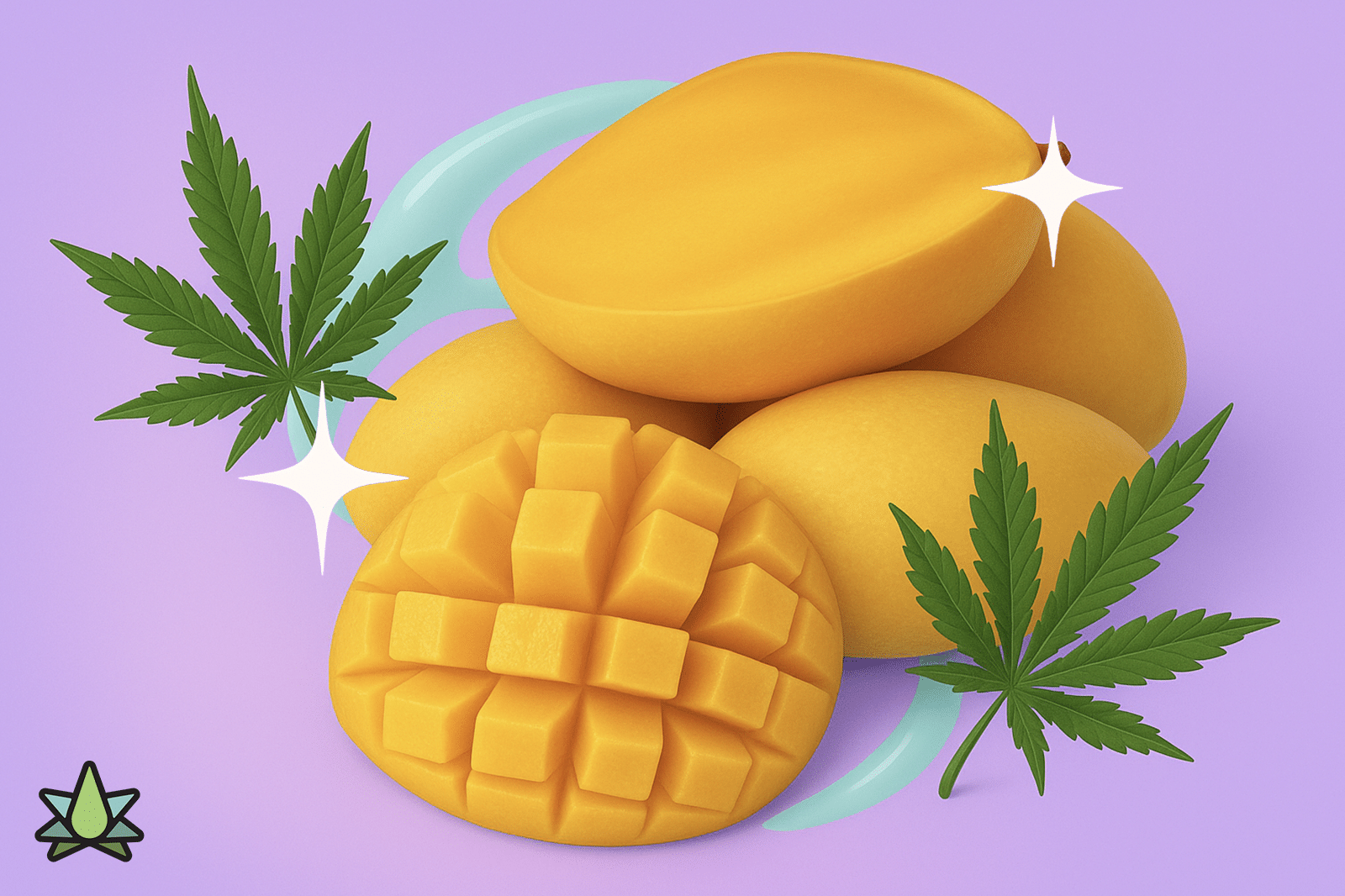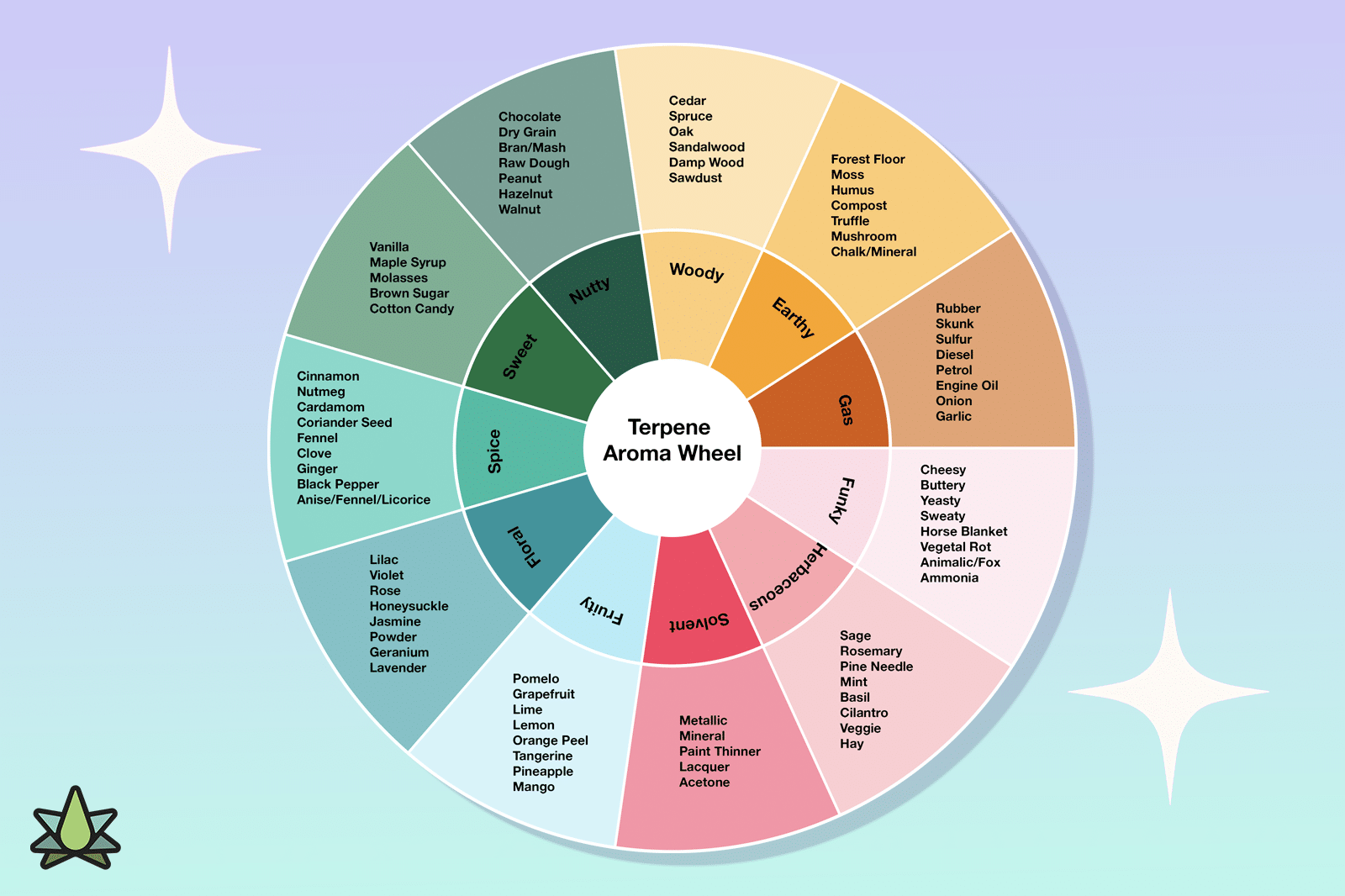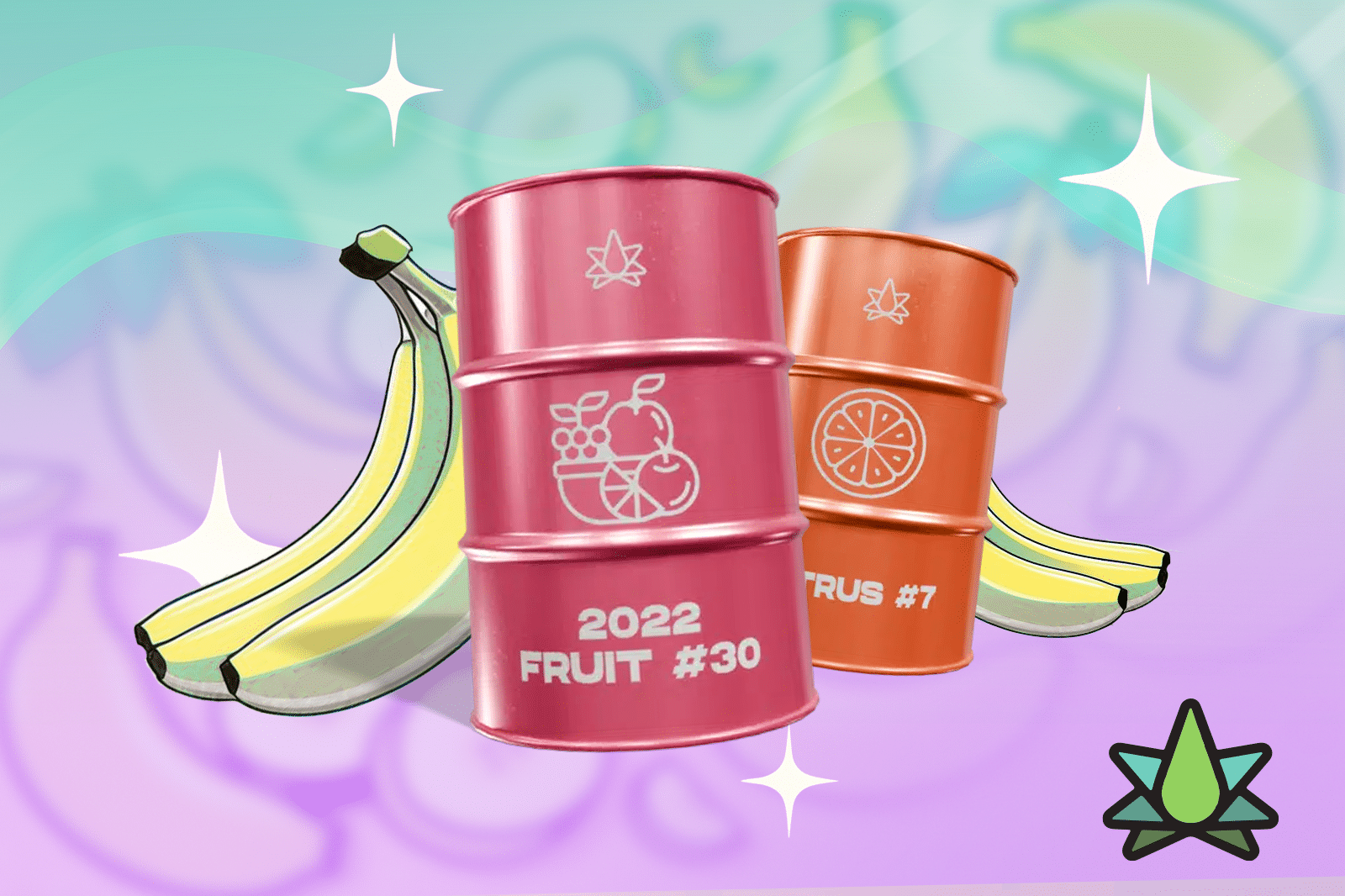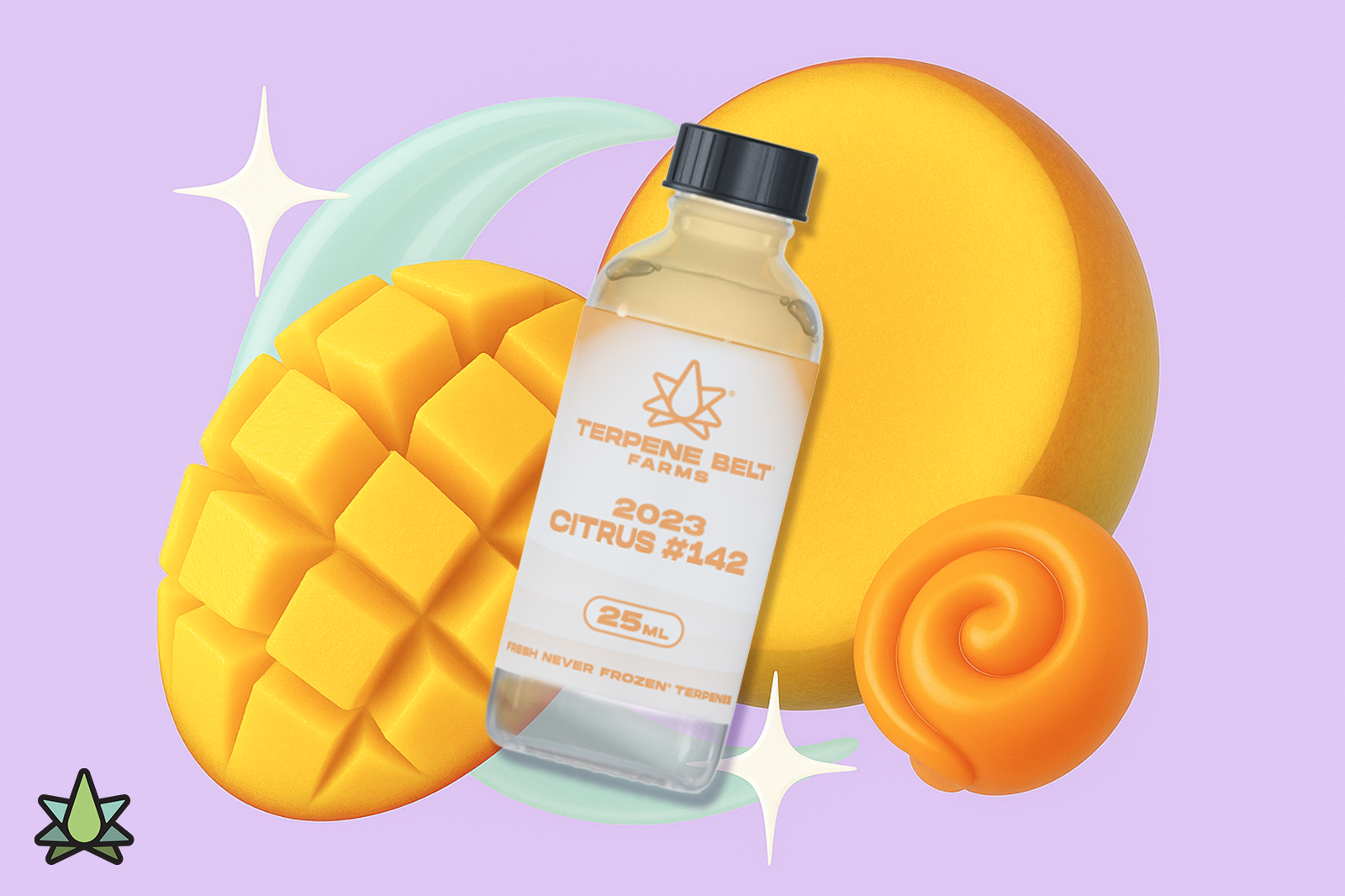The intersection of tropical fruit aromas and cannabis profiles is a fascinating area in terpene science. Product developers working with cannabis-derived terpenes (CDTs) frequently encounter formulation challenges when creating authentic mango profiles that deliver sensory accuracy and functional stability.
Understanding the chemical composition of mango fruit volatiles and cannabis-derived terpene extracts, as well as the different types of terpenes that influence aromatic expression, provides critical insights for brands seeking to develop premium products with tropical flavor experiences.
Mango terpenes — particularly the dominant compound myrcene — have generated significant interest among cannabis product formulators due to their aromatic properties and potential synergistic effects. However, implementing mango terpene formulation requires separating scientific evidence from market folklore.
This analysis delivers the data-backed insights product developers need when working with these complex aromatic compounds.
Key Takeaways
- Myrcene is the primary terpene responsible for mango’s tropical aroma, comprising 40–45% of formulations. Its precise ratio with limonene and β-caryophyllene is essential to replicate authentic mango profiles in cannabis products.
- Strains that express terpene profiles resembling mango fruit are ideal for extracting cannabis-derived terpenes that deliver tropical authenticity.
- Typical mango consumption does not provide sufficient myrcene levels to impact THC absorption or blood-brain barrier permeability.
- Successful product development depends on controlled terpene ratios, strict stability protocols (e.g., low temperature, antioxidant use), and science-backed branding, not unverified enhancement claims.
The Chemical Profile of Mango Fruit Volatiles
Natural mango fruit (Mangifera indica) contains a distinctive chemical signature that is responsible for its characteristic tropical aroma. Gas chromatography-mass spectrometry (GC-MS) analysis of ripe mango reveals a complex matrix of volatile organic compounds that contribute to its sensory profile. The primary terpene components in ripe mango fruit include:
- Myrcene: Myrcene concentrations in mango fruit range from approximately 0.13 mg/kg to 1.29 mg/kg, depending on the variety
- Limonene: Contributes citrus brightness that balances myrcene’s heavier notes
- β-Caryophyllene: Adds subtle spice notes that develop during ripening
- α-Pinene: Present in trace amounts, contributes to freshness perception
- Terpinolene: Occurs in minimal quantities, enhances floral aspects
For a broader understanding of key cannabis and hemp terpenes, check out the top 10 terpenes found in hemp.
What makes mango particularly interesting from a formulation standpoint is not the presence of these compounds but their specific ratios and interactions.
Ripe mango typically exhibits a myrcene-dominant profile, creating the foundation of its tropical character. This ratio shifts slightly across mango varieties, with Alphonso and Ataulfo cultivars generally showing higher myrcene content than Tommy Atkins or Kent varieties.
Replicating these natural ratios is essential when developing cannabis products with mango profiles. Our data indicates that mango formulations maintain myrcene levels at 40-45%, with limonene comprising 15-20% and β-caryophyllene at 8-10% of the total terpene content. These proportions create the most organoleptically accurate representation of natural mango fruit when incorporated into cannabis products.
Cannabis Strains with Mango-Like Terpene Profiles
Several cannabis cultivars express terpene profiles that closely match the chemical signature of the mango fruit. These strains are ideal for extracting cannabis-derived terpenes with tropical characteristics. Some examples of prominent mango-adjacent cannabis varieties are:
1. Mango Haze
- Strain Type: Sativa-dominant hybrid
- Terpene Profile:
- Myrcene
- Limonene
- β-Caryophyllene
- Key Characteristics:
- Closely mimics the chemical profile of real mango fruit volatiles
- Ideal for creating authentic tropical notes without relying on botanical additives
- Extraction Best Practices:
- Timing is critical: harvest 2–3 days before the typical commercial schedule
- Early harvests risk low myrcene development; late harvests increase oxidation and terpene degradation.
2. Mango Kush
- Strain Type: Indica-dominant hybrid
- Terpene Profile:
- Myrcene (dominant)
- Caryophyllene
- Pinene
- Key Characteristics:
- Aroma and flavor reminiscent of ripe mangoes with earthy and pine undertones
- Produces euphoric and uplifting effects, transitioning to relaxation
- Dense, sticky buds with orange pistils
- Extraction Best Practices:
- Utilize low-temperature extraction methods (e.g., cold ethanol or subcritical CO₂) to preserve volatile terpenes like myrcene
- Implement vacuum distillation to reduce oxidation and maintain terpene integrity
3. Mango OG
- Strain Type: Indica-dominant
- Terpene Profile:
- Myrcene (dominant)
- Caryophyllene
- Limonene
- Key Characteristics:
- Sweet, tropical mango flavor with subtle creaminess
- Offers euphoric and uplifting effects with a gradual onset
- Ideal for mood enhancement and stress relief
- Extraction Best Practices:
- Employ hydrocarbon extraction (e.g., butane) at low temperatures to capture the full spectrum of terpenes
- Ensure proper purging to remove residual solvents while preserving flavor
These strains are celebrated for their mango-like flavors and aromas, primarily due to the presence of myrcene and other complementary terpenes. When extracting terpenes from these strains, it’s crucial to employ methods that preserve their delicate profiles to maintain the desired sensory experiences.
Our Sweet#161, Purple#100, and Fruit#132 have terpene profiles that exhibit mango-like flavor and aroma. They are also rich in myrcene and complementary terpenes like those in mangoes.
The Mango-Myrcene Effect: Scientific Evidence vs. Market Folklore
One of the persistent myths in cannabis consumer circles is that consuming mango before using cannabis enhances the psychoactive effects due to myrcene content.
This belief has spawned numerous articles, product recommendations, and even dedicated “mango-pairing” events in the cannabis community. However, examining the scientific evidence reveals a different reality.
Understanding the Origin of the Myth
The mango-enhancement theory stems from the fact that myrcene is mildly sedative in high concentrations and may improve the blood-brain barrier’s permeability. Theoretically, this could enhance cannabinoid absorption.
However, this mechanism requires specific concentrations that are not possible to achieve even with everyday mango consumption.
What Research Shows
Controlled studies examining the impact of mango consumption on THC absorption and psychoactive effects have failed to demonstrate measurable differences between subjects who consumed mango and control groups.
The fundamental flaw in the mango-enhancement theory lies in concentration levels. To potentially impact blood-brain barrier permeability, myrcene would need to reach substantially higher blood concentrations than possible through typical fruit consumption.
The average mango contains approximately 0.13 mg/kg to 1.29 mg/kg, meaning even a large mango provides insufficient quantities to significantly alter physiological processes in the timeframe suggested by the folk wisdom.
Implications for Product Developers
For product developers and brand marketers, this research has important implications:
- Marketing claims suggesting enhanced effects through mango terpene additions lack scientific substantiation and may expose brands to compliance risks
- Formulations should prioritize sensory accuracy and product stability rather than unsubstantiated effect claims
- Educational materials should focus on specific terpenes’ aromatic experience and potential wellness benefits rather than perpetuating myths about psychoactive enhancement.
Our formulation philosophy centers on creating authentically aromatic experiences without making unsupported claims. This approach respects regulatory boundaries and builds long-term consumer trust by consistently fulfilling brands’ promises.
Practical Formulation Guidelines: Dosage and Stability Considerations
When incorporating mango terpene profiles into cannabis products, precise dosage control and stability management are critical. Different product formats require different inclusion rates to achieve optimal sensory and effect results.
Optimal Inclusion Rates by Product Category
| Product Format | Recommended Inclusion Rate | Maximum Safe Limit | Stability Considerations |
| Vape Oil/Distillate | 5-10% | 12% | Higher temps accelerate myrcene degradation; store below 70°F |
| Concentrates | 4-7% | 10% | Limit exposure to oxygen during production |
| Flower/Pre-rolls | 1.5-2.5% by weight | 3.5% | Apply in a controlled humidity environment (58-62% RH) |
| Edibles | 0.05-0.1% | 0.15% | Encapsulation improves heat stability during processing |
| Beverages | 0.01-0.03% | 0.05% | Requires emulsifier; best preserved in non-transparent packaging |
| Topicals | 0.25-0.5% | 1.0% | Incorporate antioxidants to prevent oxidation |
These recommendations reflect extensive stability testing and sensory evaluation to determine the optimal balance between aromatic impact and product integrity. Exceeding the maximum limits can result in overwhelming sensory characteristics and potential instability issues in the finished product.
Myrcene Stability Management in Formulations
Myrcene presents specific stability challenges in product formulations due to its chemical structure.
As an acyclic monoterpene, myrcene contains three double bonds susceptible to oxidation, especially when exposed to heat, light, or oxygen. This vulnerability necessitates specific handling protocols:
- Temperature control: Maintain production environments below 75°F when working with myrcene-rich formulations; cold processing (below 65°F) significantly extends shelf life.
- Oxygen limitation: Utilize nitrogen purging during production and packaging to displace oxygen; vacuum packaging provides additional protection.
- Antioxidant incorporation: Adding natural antioxidants like tocopherols at 0.01-0.05% can dramatically improve myrcene stability without affecting sensory properties
- pH management: Maintain slightly acidic conditions (pH 5.0-6.0) in liquid formulations to minimize degradation rates
- Light protection: Use amber or opaque packaging to prevent photodegradation of vulnerable terpene compounds
Mango terpene profiles can maintain sensory integrity for 12-18 months in most product formats when properly stabilized. However, they degrade significantly under suboptimal storage conditions, with noticeable aromatic shifts occurring within 60-90 days when exposed to elevated temperatures or oxygen.
Product developers should conduct accelerated stability testing specific to their formulations, as matrix interactions can significantly impact terpene stability profiles. This testing is crucial for products with longer distribution chains or those targeted at markets with challenging climate conditions.
3 Brand Positioning Strategies for Mango Terpene Products

The tropical character of mango profiles offers unique positioning opportunities for cannabis brands. Consumer research indicates that mango aromatics consistently rank among the most universally appealing flavor profiles.
For entrepreneurs looking to leverage such high-demand profiles, understanding how to start a cannabis brand with strong sensory differentiation is crucial to standing out in a competitive market. Effective brand positioning strategies for mango-forward products include:
Tropical Escape Positioning
Marketing language and visual elements that emphasize vacation-like experiences connect naturally with mango’s tropical associations. This positioning works well for products intended for relaxation-focused consumption occasions.
Brand stories that link the product experience to tropical destinations resonate strongly with consumers seeking momentary escapes from everyday stresses.
Culinary Sophistication Angle
For brands targeting more sophisticated consumer segments, positioning mango terpene products within a culinary context elevates the consumption experience. Emphasizing terpene similarities between premium mango cultivars and specific cannabis strains creates a connoisseur-level narrative that appeals to experience-focused consumers.
Wellness-Focused Messaging
While avoiding unsubstantiated effect claims, brands can authentically position mango terpene products within wellness frameworks by focusing on the sensory experience and potential mood benefits of aromatic compounds.
Terms like “uplifting,” “bright,” and “mood-enhancing” accurately describe the subjective experience many consumers report with mango-adjacent aromas without making specific physiological claims.
Successful mango terpene products typically combine these positioning elements based on specific target consumer segments and consumption occasions. The most effective approaches maintain consistency across packaging, naming conventions, and marketing materials to reinforce the tropical experience promised by the mango profile.
Conclusion: The Future of Mango Terpenes in Cannabis Product Development
Mango-inspired terpene profiles offer a compelling combination of mainstream appeal and formulation flexibility. Their familiar yet complex aromatic character provides product developers with versatile building blocks for creating memorable sensory experiences across multiple product categories.
For brands seeking to develop standout products in this space, the competitive advantage lies in formulation precision, stability management, and authentic storytelling that respects science and the sensory experience. By focusing on these elements rather than perpetuating unfounded myths, product developers can create premium offerings that deliver on their aromatic promises.
Through continued research and refined extraction techniques, Terpene Belt Farms is committed to providing product developers with the highest quality cannabis-derived terpene profiles.
Our California-grown cannabis genetics, selected specifically for their unique terpene expressions, provide the authentic foundation that discerning brands require for premium product development.
Frequently Asked Questions
What Makes Myrcene an Important Terpene in Mango-Inspired Cannabis Products?
Myrcene provides the musky-sweet tropical base that defines mango’s aroma. It’s the most abundant terpene in both mango fruit and mango-like cannabis strains, typically comprising 40–45% of a well-balanced tropical terpene profile.
Can Eating Mangoes Enhance the Effects of Cannabis?
No, scientific studies show that the amount of myrcene in a typical mango is too low to impact THC absorption or psychoactive effects meaningfully. This popular belief is based more on folklore than on proven science.
Which Cannabis Strains Naturally Resemble the Aroma of Mango?
Mango Haze, Somango, and Granddaddy Purple are three strains with terpene profiles similar to mango fruit. They are frequently used as source material for cannabis-derived terpene formulations targeting tropical aromas.
How Can Product Developers Ensure Stability in Mango Terpene Formulations?
To maintain aroma integrity, developers should control heat, oxygen, and light exposure during processing and packaging. Techniques like nitrogen purging, using antioxidants, and cold storage can extend shelf life and prevent terpene degradation.
Sources Cited
Dvorakova, M., Wilson, S., Corey, W., Billingsley, J., Zimmowitch, A., Tracey, J., Straiker, A., & Mackie, K. (2022). A critical evaluation of terpenoid signaling at cannabinoid CB1 receptors in a neuronal model. Molecules, 27(17), 5655.
National Center for Biotechnology Information (2025). PubChem Compound Summary for CID 31253, Myrcene. Retrieved May 20, 2025, from .
Tandel, J., Tandel, Y., Kapadia, C., Singh, S., Gandhi, K., Datta, R., Singh, S., & Yirgu, A. (2023). Nontargeted Metabolite Profiling of the Most Prominent Indian Mango (Mangifera indica L.) Cultivars Using Different Extraction Methods. ACS Omega, 8(43), 40184–40205.



